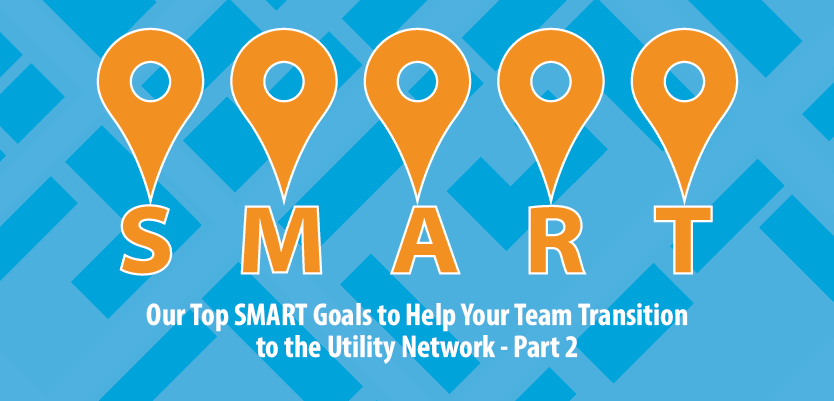In our last article Our Top SMART Goals to Help You Transition to the Utility Network – Part 1 we discussed the important role that preparation plays in technology transitions. We discussed the value of good communication with your workforce and outlined impactful change management goals for GIS & Technology Managers. To further help you prepare for your Utility Network (UN) transition, as promised, today we will provide SMART goals for your GIS Editing Teams and GIS Technical Teams. These goals will focus on workforce skills and foundational knowledge of ESRI Utility Network Technology. And as a bonus, we will include ideas on how to keep GIS Stakeholders engaged with their own goals.
With the new year just beginning it is a great time to reflect on where your organization is at regarding UN readiness. Step back and consider if your team has the skills and support needed for this technology transition, especially if you are already mid-implementation.
Curve Balls and All-star Teams
Before we dive into each team’s goals, let us recall a portion of our GIS & Technology Manager goals. Goal 3 & Action 3 was to determine your roles and resources and identify your implementation team and other key stakeholders. That same Mckinsey & Company study we have mentioned previously, also says that a project’s success is more than three times more likely when organizations have invested the right amount in digital talent, i.e. having appropriately funded and robust talent pools.
It may seem obvious, that you need the right talent in the right place. However, GIS managers are particularly challenged right now. The Great Resignation has uprooted many teams. Employees have demanded better salaries, more benefits, and flexible schedules while managers have been left with pre-COVID policies that often outdate these demands. On top of everything else, the veteran GIS community is adapting to emergent technologies, and economic uncertainty may be impacting your larger organization. Needless to say, managers are no stranger to daily curve balls, but curve balls can still thwart you from reaching your goals.
As we look at the SMART goals for your teams, consider your expected workforce obstacles and your strategy to address them if and when they occur. Your toolkit for building the best all-star team includes five workforce planning strategies: retention planning, upskilling, new hiring, staff augmentation, and outsourcing. The objective is to keep your team’s skills at a level to fit your program and timeline needs. Begin by documenting your key employees and key positions, including identifying role gaps. Then after reading the SMART goals, start your Workforce Plan by determining a strategy and filling in details about how you can execute.
Workforce Plan template:
GIS Department Workforce Plan
| Name (Key Employees) | Role (Key Positions) | Workforce Strategy | How | Action Items and Considerations |
|---|---|---|---|---|
| John Doe | GIS Analyst | Retention | Praise, bonus, title change, etc. | Plan HR title review meeting. |
| Mary Sue | GIS Tech | Upskill | Utility Network training, ArcGIS Pro training, etc. | Potential fit for GIS Analyst. Estimated time to upskill 1 year. |
| TBD | GIS Developer | New Hire/Outsourcing | Increased headcount or budget. | Discuss options & budget with upper management. |
Now, let’s review the SMART goals.
The Smart Goals for GIS Editing Teams
GIS Editors, Technicians, and QA/QC Teams have a straightforward focus- supporting critical business processes and data by properly using and maintaining a Utility Network. Each year we see mobile applications consuming more data entry workflows performed by operations. As a result, good performers in this group will begin to transform their skills from data entry to data maintenance (QA/QC and network validation skills). Those that want to exceed in their role will work towards a more in-depth understanding the data model and technologies. Practice caution on giving stretch assignments to this group as it could be impractical for some personnel. However, growing your bench strength will pay off in the long run if approached strategically.
- Goal 1 – Gain a working level knowledge on ArcGIS Pro. Complete the ESRI Migrate to ArcGIS Pro Learning Plan or equivalent training as needed by x date. This plan is 4 free courses and one instructor-led paid course.
- Goal 2 – Gain a solid understanding of Web GIS concepts and how web GIS will benefit the organization. Complete the free ESRI ArcGIS Enterprise: An Introduction video. Complete by x date. Or, for those with previous web GIS exposure, refamiliarize yourself with the free Web GIS: A Crash Course video by x date.
- Goal 3 – Gain fundamental knowledge of Utility Network concepts. Complete the free courses in the ESRI Utility Network Fundamentals Learning Plan (5 free courses) by x date. Closer to deployment consider the taking the instructor-led paid course Working with Utility Networks in ArcGIS.
The Smart Goals for the GIS Technical Teams
GIS Developers & Analysts are the people that will get your implementation over the finish line. By necessity they need to have a solid understanding of the technology concepts (GIS Editing Teams goals), as well as a configuration and deployment concepts outlined in the goals below. Demand for GIS, IT, and technical teams continues to grow, and their roles are requiring more specialized utility domain experience that may be hard to attain and retain. Establishing your Workforce Plan for this group is most essential.
- Goal 1 – Gain a working level knowledge of the Utility Network. Complete the ESRI Utility Network Fundamentals Learning Plan by x date. Including the instructor-led paid course Configuring Utility Networks in ArcGIS.
- Goal 2 – Set up an internal Utility Network sandbox environment. Choose the one ESRI foundation solution that best fits your commodity below and deploy the solution in a prototype single user environment on your internal network. Complete the foundation project tasks by x date (prior to project kickoff). In the Goal 1 Configuring course, users will deploy a prototype in the ESRI’s training environment and have access to course instructors. Having a deployment on your internal network will provide you a sandbox for ongoing testing. Setting the prototype in a file geodatabase will allow you to quickly test specifications without the cost of an enterprise sandbox. If you must pick between goal 1 and goal 2, guide most users to goal 2 and reserve goal 1 for a top performer.
Chose your foundation:
- Goal 3 – Familiarize yourself with the latest ESRI Data Model release for your commodity prior to project kickoff. Set up a debrief meeting with your peers to quiz each other on the insights you gained and measure your retention.
- Goal 4 – Gain a working level knowledge of Arcade such that you can comprehend, discuss, or build Attribute Rules and support web applications. Complete the ArcGIS Arcade Fundamentals Learning Plan by x date.
The Smart Goals for Stakeholders
The most important factor for stakeholder goals is to incentivize data and technology use. Stakeholders should feel empowered to become self-serving through your applications. The technology barrier is sometimes smaller for corporate stakeholders than it is for operations. So, determine ways you can get others, particularly operations, excited about your new tech and help them embrace how it will make their lives easier in the future.
- Goal 1 – Document 1-3 pain points you experience with GIS every quarter prior to project initiation. These can be issues or cumbersome workflows associated with viewing web maps, design, as-builting, inspections, reports, etc. Something that impedes your workday. Submit issues to GIS leaders.
- Goal 2 – Help the company identify data improvement opportunities. Identify existing sources for large scale data clean-up efforts or submit 5-10 redlines (map corrections) to GIS Editing Teams every quarter. We’ve seen some clean up attempts cause more harm than good regarding the relationship between GIS and operations because of the approach taken. When you begin your data clean up planning, first reassure operations staff that every stone will be overturned in your hunt to update the map and their past efforts (existing documents, as-builts, designs, material records, etc.) will not go to waste. Still, it is imperative for everyone to contribute to data quality exercises moving forward.
Conclusion
Managing teams and writing good SMART goals is time consuming. We hope this list helps utility GIS workforces jumpstart their Utility Network and Web GIS technology transitions by focusing on the areas that will be the most impactful to their journey. Remember that goals do not have to be perfect on day one. Strive to refine your goals every quarter to be more Specific, Measurable, Achievable/Ambitious, Relevant, and Time Bound based on your individual, team, and corporate needs. Work to preemptively establish a Workforce Plan for predictable role and resource problems. This can ease stress and ensure your team stays on track for your Utility Network transition.
*ESRI course prices may vary based on your ESRI license agreements and yearly price adjustments. Courses listed above are presently listed at $1,790.


What do you think?